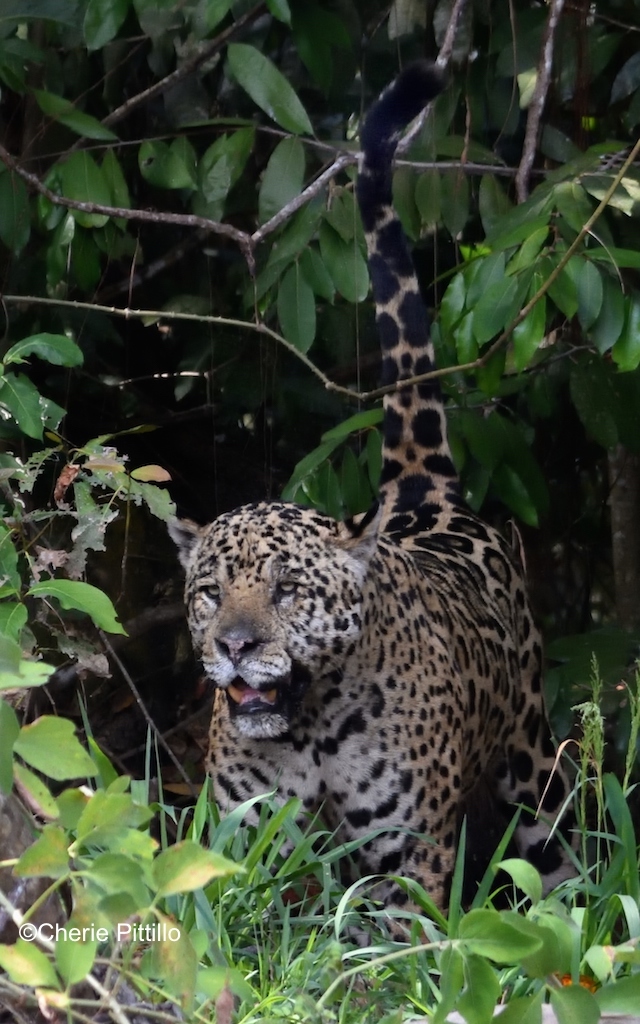The Mayan gods rarely granted any miracles, but one of them was to allow a man to meet face to face with the great Jaguar: symbol of strength and guardian of the underworld, according to its Maya cosmogony.
The jungle of Quintana Roo is Jaguar Territory, and if you dare, you can sleep five nights under starry skies to learn how to track the third largest cat in the world in its own habitat.
Even though the possibilities of sighting a Jaguar are remote, the experience will be unique and you will learn a lot about the behavior of this amazing species. During the trip you are accompanied by biologists and scientists from the UNAM, who are dedicated 100% to study the Jaguar.
Let the search begin
Day One
The trip begins in the wetlands of the Sian Ka’an Biosphere Reserve, four hours south of Cancun.
Your first encounter with nature consists of a walk through the jungle until you reach the Chunyaxché lagoon, with its fresh water channels that the Maya used to sail. You can swim or just float in it: the current allows you to drift without problem and it pushes you gently, without the need to move one finger of your body.
The ride lasts about three hours, until you get to Kantemó, a place that holds a secret, but to discover it you need to wait for the sun to set on the horizon.
Again, you hit the jungle, but this time on a bicycle to reach the “cave of snakes”. The cavern is inhabited by dozens of these reptiles that hang from the ceiling and walls, hungry for bats, but do not worry, you are not part of their diet.
The guides of Ecocolors, company that organizes this expedition, take infrared lamps so that you can see thousands of bats leaving the cave in search of food and the snakes hunting them as they flock out of the cave into the night.
The first day of adventure is over. The camp is ready for you to take a bath, and then you will join the campfire for a dinner under the stars, chicken pibil and a cold beer.
Feline expedition
The next morning, the camp rises to move to the ejido Laguna OM, located on the border with the Calakmul Biosphere Reserve, in Campeche.
You arrive at one of the research stations of the jaguar managed by the UNAM. According to its monitoring, this is the area where the largest concentrarion of jaguars in Mexico, around 1,500. The scientists explain the itinerary of the following three days: morning, afternoon and evening walks to look for footprints: bent or broken branches, hair, tracks, and cat stool. And, if you are lucky enough, maybe you will be able to spot a jaguar near the aguadas (temporary lagoons formed by the rain) that surround the station.
To see fantastic photos of Jaguars in the wild click here
Jaguars are nocturnal animals. However, the search for footprints and tracks takes place during the day.
Sometimes, to find a footprint, it takes up to three hours. The guides will equip you with magnifying glass to identify hairs stuck in the bark of the trees, binoculars to try to find a feline lying on a branch at a distance, and gloves in case you have to collect feces.
During the tracking, the local guides tell stories of what the Jaguar represented for the Maya. Besides the power, they associated the feline with the Universe. For the Maya, the spots on the Jaguar skin were a representation of the constellations.
Click here to check out the amazing photographic material of Cherie Pitillo
And when the miracle of observing a Jaguar in the wild actually happens, you must be ready with the camera zoom try to stay as still as possible, keep totally silent, and take the photos of a lifetime.
The walks can extend to the archaeological zone of Chacchobén, about 100 kilometers away from the scientific station. Its foundations were used as astronomical observation and ceremonial centers.
The last day of the trip is reserved for swimming in the cenotes of the “lagoon of the seven colors” in Bacalar, southern Quintana Roo. This magnificent lagoon boasts several different tonalities of blue, as the rays of the sun illuminate the white sands at different depths through the water.
For more amazing Jaguar photos by Cherie Pitillo click here
The trip includes local transportation, overnight accommodation in Cancun (before and after the trip), three meals a day, camping equipment, entry fees, guides and travel insurance.
The next tour will take place from April 12 to 18. Ecocolors Tours. Ph.- +52 (998) 884 3667.
TYT Newsroom with information from:


